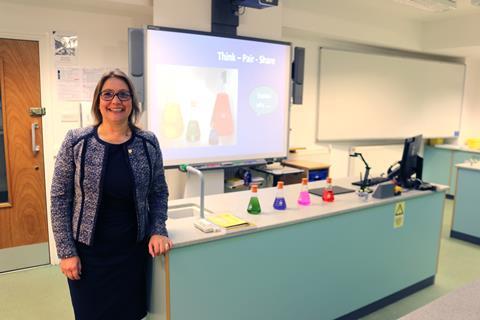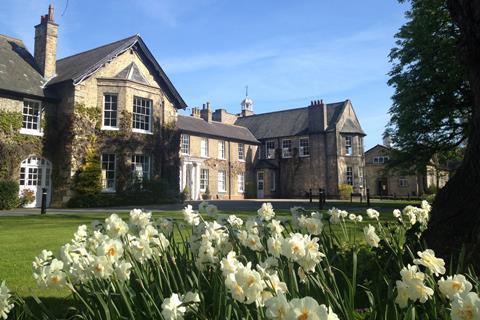Teaching spaces where discussion, discovery and storytelling bring the science to life

Meet Jenny McDowell and David Hutchings from Pocklington School in York. Jenny has taught 11–18 chemistry for 27 years and is currently head of chemistry at Pocklington, where she’s been teaching for 11 years. David has taught physics at Pocklington for 17 years. He’s a fellow of the Institute of Physics and author of several books, including Let there be Science: Why God loves science, and science needs God and God, Stephen Hawking and the Multiverse.
Tell us about your school.

Jenny: It’s a warm and friendly independent school for students between the ages of 3 and 18, where students are encouraged to achieve their potential – and they thrive.
Pocklington School was founded in 1514 by visionary lawyer and clergyman John Dolman, who understood the value of education. The school’s values of truth, trust and courage have been at the heart of the Pocklington ethos from the start, and have continued to inspire for over 500 years.
There are currently 760 day and boarding students. Boarding is central to the life of our community and it brings diversity – we have students from 15 different countries at Pocklington.
What’s your teaching space like?
Jenny: The chemistry laboratory is an open and bright space. The layout of the tables enables students to work in teams and easily access the equipment needed for practical work. I’m also able to move around each group to support their work, as needed. There are different classroom displays to help inspire independent learning and support students to ‘build their thinking power’ and increase their interest in the applications of chemistry.

At the front of the lab, we make beneficial use of a visualiser and tablet which is integrated with an interactive whiteboard to facilitate classroom learning and discussion. There is an additional large whiteboard and various resources to support students’ learning, including mini whiteboards. The main computer has a fixed webcam for students joining a Zoom lesson if they need to learn remotely as we work through the disruption from Covid-19.
We have a display to prompt students on how to approach science questions and avoid misconceptions with command words. Another display shows how we have been promoting ‘Science in the news’ with COP26, and others including ‘Black history month’ with students’ research on famous Black scientists. This has been linked with a focus on these issues during tutor time.
Our department created one of my favourite displays on the periodic table. We had fun taking photos of letters found around the school and Pocklington town to represent the symbols of the elements in periods 1–4.
What’s your favourite part of your classroom?
Jenny: Students are the key to my classroom, and I thrive with the buzz of them asking questions as they discover new concepts through discussion and practical work, demonstrating perseverance with any difficulties. My aim is to always provide a professional and welcoming environment for Pocklington students.

How do you enhance your teaching space?
David: I see teaching science as storytelling: who did what, when, why and how? Can students imagine themselves in that situation? What would they have thought of? What would they have done? Did other people look at the same problem, but hit a dead end? What does real science look like – is it always successful?
By putting science into the context of its history and philosophy, it becomes more human. And so, I’ve found, more students take an interest when you do. Why limit science to abstract concepts and facts – and, in so doing, to certain personalities only? We can open it up far more than that! Who knows how many potentially excellent scientists we’ve missed out on because they didn’t hear the stories that real science carries, including its mess and failures?
This is why my favourite part of the job involves no writing, calculating or even lab equipment: story time.
What one thing would you choose for your classroom if you had an unlimited budget?
Jenny: I have valued the spectroscopy in a suitcase resource. Before Covid, we had regular visits from university research chemists. They brought portable IR and NMR machines to the school and our students analysed aspirin and paracetamol samples they had synthesised and tested their purity. With an unlimited budget, I would purchase a portable IR or NMR machine. It would be amazing for our students to have the opportunity to analyse different samples synthesised in the laboratory.
What one thing would you choose for your classroom if you had an unlimited budget?
Jenny: I have valued the spectroscopy in a suitcase resource. Before Covid, we had regular visits from university research chemists. They brought portable IR and NMR machines to the school and our students analysed aspirin and paracetamol samples they had synthesised and tested their purity. With an unlimited budget, I would purchase a portable IR or NMR machine. It would be amazing for our students to have the opportunity to analyse different samples synthesised in the laboratory.









No comments yet